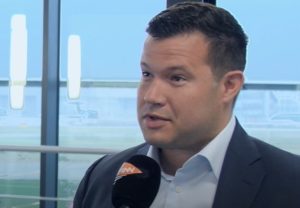EVE Air Mobility has spent the last two years preparing for entry into the urban air mobility market, not only with the eVTOL itself, but with the company’s urban air traffic management solution, MRO and services and support functions.
 David Rottblatt, Vice President of Business Development said Rowblatt said: “We’re much different than the conventional urban air mobility company where most companies are only focused on developing the vehicle. We also have a pretty agnostic portfolio of service and support capabilities and so we recently announced the fact that we’re in a SPAC deal which we expect to close very soon and then we’ll be trading on the New York Stock Exchange as EVEX and we are very excited about that.”
David Rottblatt, Vice President of Business Development said Rowblatt said: “We’re much different than the conventional urban air mobility company where most companies are only focused on developing the vehicle. We also have a pretty agnostic portfolio of service and support capabilities and so we recently announced the fact that we’re in a SPAC deal which we expect to close very soon and then we’ll be trading on the New York Stock Exchange as EVEX and we are very excited about that.”
The New York Stock Exchange welcomed executives and guests of EVE Mobility Acquisition Corp (NYSE: EVE) in celebration of its initial public offering to ring the NYSE Opening Bell on February 1, 2022. Embraer will hold 82 per cent of the resulting firm’s equity after the transaction, which values Eve at $2.4bn. Proceeds of the deal will be used to develop and commercialise the company’s urban air mobility capabilities.

Shuttle journeys will be “heart of early adopter demand”
Rottblatt said that EVE would initially be concentrating on shorter journey use cases. He explained: “We’re focusing on the urban air mobility market, a market that we think is well addressed within a hundred kilometre range. Our eVTOL aircraft is expected to reach up to 100km on a single charge but given the use cases that we’re targeting, things like the airport shuttle use case, commuter and tourism applications of our vehicle, we expect that the average ship will be between somewhere 20 to 30 km.”
“We think is is at the heart of what we think early adopter demand will be for this type of technology, to really alleviate the pain point of traffic that so many people feel and this is something that is no stranger to London and the greater UK as well.”
eVTOL could enter service in 2026
Rottblatt forecast EVE would get to certification in 2025 and would enter service by 2026, but that it would take five to ten years for the industry to scale. He explained: “What we’ll start to see is as this industry begins to scale, people will become more familiar with what these aircraft look like and then, over time, we’ll be able to collaborate with communities and understand how they want to use this so that the way that we build those businesses in line with the way that the community wants to use it.”
Explaining the benefits of the new urban air mobility vehicles to the public would be one issue for the entire urban air industry to overcome. Rottblatt explained that the aerospace industry was no stranger to innovation and added that EVE had been working with other organisations within the UK to create a concept of operation: “I think the challenge that we will have, and anyone will have, is making sure that the community really understands how this can be of value to them. It’ll be an asset to them and the way that trust is established is by sitting together learning and listening together with the communities.”
He added: “One thing that EVE Air Mobility is doing, to that end, is producing a concept of operation, a team that we have been leading in the UK together with NATS, London City, London Heathrow Airport, the innovation team within the UK Civil Aviation Authority as well as several of our peers in this space. We plan on delivering an original contribution for how this industry will work right here in the UK and we’ll look forward to getting stakeholder feedback on that.”

